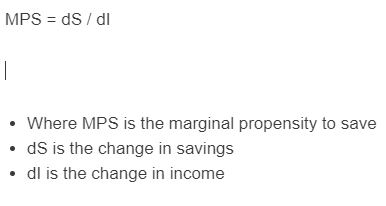Enter the total change in savings and the total change in income into the calculator to determine the marginal propensity to save.
- MPC Calculator
- Marginal Product of Labor Calculator
- Marginal Cost Calculator
- FIRE Calculator
- Export Ratio Calculator
MPS Formula
The following formula is used to calculate the marginal propensity to save.
MPS = dS / dI
- Where MPS is the marginal propensity to save
- dS is the change in savings ($)
- dI is the change in income ($)
To calculate the marginal propensity to save (MPS), divide the change in savings by the change in income.
MPS Definition
MPS, known as marginal propensity to save, is a measure of how much extra money a person saves when they receive an increase in income.
MPS Example
How to calculate marginal propensity to save?
- First, determine the change in savings.
Measure the total change in savings amount per period.
- Next, determine the change in income.
Calculate the total change in income.
- Finally, calculate the marginal propensity to save.
Calculate the MPS using the equation above.
FAQ
MPS stands for a marginal propensity to save. It’s a measure of how much extra a person saves with a change in income. The closer the MPS is to 1, the greater the savings rate of the person.

